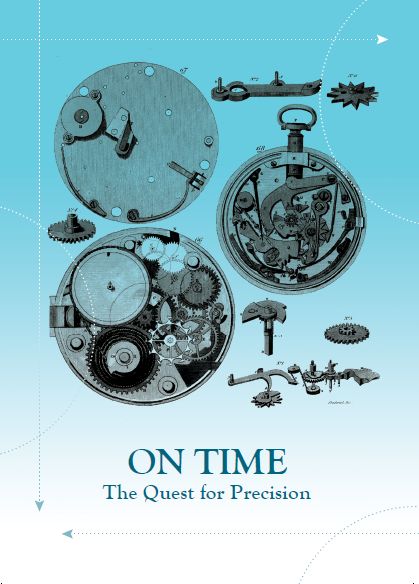September 14 - November 19, 2016
On Time: The Quest for Precision: An Exhibition of Books on Time and Timekeeping from the Linda Hall Library
Curated by Bruce Bradley

From sundials to atomic clocks, the exhibition On Time: The Quest for Precision explores the history of precise timekeeping through rare books that taught readers techniques of timekeeping, announced new inventions, and provided instructions on the construction and use
of timekeeping instruments. On public exhibition at the Grolier Club from September 14 - November 19, 2016, the works are drawn from the collections of the Linda Hall Library of Science, Engineering & Technology, Kansas City, Missouri.
Curator Bruce Bradley tells a timely story with 86 illustrated books dating from the fifteenth century to the present that graphically and artistically depict the sweep of timekeeping. “These books are fascinating and ornate, as well as informative about the innovations that have led to increasingly precise timekeeping devices,” notes Mr. Bradley. As a complement to the printed books, the exhibition includes a small selection of historical clocks and timepieces from the collection of Grolier Club member Fortunat Mueller-Maerki: sundials, a clepsydra or water clock, a variety of clock maker’s tools, weight driven clocks, marine chronometers, American railroad-grade pocket watches, and an Accutron desk clock.
The early books describe techniques for timekeeping with fantastic illustrations of sundials and water clocks. In Magnes siue De arte magnetica opus tripartitum (Rome, 1641), Athanasius Kircher provides a detailed, full-page engraving of a sunflower clock floating on a piece of cork with its roots in the water. Vegetable magnetism supposedly caused the flower to follow the sun, so that a pointer fixed in the center would indicate the hour on a clock dial. A book that featured more traditional types of sundials is Sebastian Münster’s Horologiographia (Basel, 1533). This comprehensive treatise was first issued as Compositio horologiorum in 1531, but it was popular enough to warrant this second enlarged edition just two years later. Both editions illustrate a variety of sundials with beautiful woodcuts, some of which are attributed to Hans Holbein the Younger.
A book that described and illustrated some of the best astronomical instruments of the sixteenth century is Tycho Brahe’s Astronomiae instauratae mechanica (Nuremberg, 1602). Of the four clocks in his observatory, two of the smaller clocks are shown in the plate of the famous mural quadrant that Brahe used for making observations of star positions. Brahe explained that he used two clocks to reduce errors in recording the exact moment of observation.
The innovation that made mechanical clocks possible, the escapement mechanism, was first illustrated in a seventeenth-century book by Robert Fludd. An English clergyman, William Derham, produced the first practical manual on clock making, The Artificial Clock-Maker (London, 1696). Much of Derham’s knowledge of clocks came from his friend, Robert Hooke, who was involved in priority disputes over horological innovations such as the anchor escapement and the balance spring regulator for watches.
Pendulum clocks represented a revolution in timekeeping devices. They had greater accuracy than any other clocks and became standard pieces of scientific equipment, particularly for astronomical observatories. Christiaan Huygens designed the first successful pendulum clock and described it in his classic book on display in the exhibition, Horologium oscillatorium (Paris, 1673).
In the twentieth century, Nature, a scientific journal known for publishing new advances and original research, published the description of the first atomic clock, designed and built by Louis Essen and Jack Parry at the National Physical Laboratory in Teddington, England. Atomic clocks led to a new definition of the second at the 1967 meeting of the International Bureau of Weights and Measures in Paris.
CATALOGUE: A 60-page illustrated catalogue is available for purchase at the Grolier Club for $15. The exhibition and its associated catalogue are supported by a generous grant from the Ascher Family Foundation and by the Linda Hall Library Foundation.
About the Linda Hall Library: The Linda Hall Library is among the world’s foremost independent research libraries devoted to science, engineering, technology, and their histories. Founded in 1946 through an endowment created by Linda and Herbert Hall, the library is a not-for-profit, privately funded institution, and is open to the public free of charge. Scholars, technologists, engineers, researchers, academic institutions and businesses, nationally and internationally, use the Linda Hall Library’s collections to investigate, invent, and increase knowledge. The Library’s holdings range from rare books to private papers, including extensive collections in diverse areas such as aeronautics, astronomy, engineering standards, a resource center for patents and trademarks and more. In addition to the Library’s resources, hundreds of people attend the Library’s public programs throughout the year to expand their awareness and understanding of science and technology. To learn more, visit www.lindahall.org.
About the Grolier Club: The Grolier Club of New York is America’s oldest and largest society for bibliophiles and enthusiasts in the graphic arts. Founded in 1884, the Club is named for Jean Grolier, the Renaissance collector renowned for sharing his library with friends. The Club’s objective is to foster the literary study and promotion of arts pertaining to the production of books.
VISITING THE GROLIER CLUB: 47 E. 60th Street, New York, NY 10022. Open to the public free of charge, Monday-Saturday, 10 AM to 5 PM.
FOR FURTHER INFORMATION: please contact Exhibitions Manager Jennifer Sheehan at [email protected] or 212-838-6690; or PR Consultant Susan Flamm at [email protected] or 212-289-2999.
FORTHCOMING EXHIBITIONS:
· 7 December 2016 – 4 February 2017. "A True Friend of the Cause: Lafayette and the Anti-Slavery Movement." Curated by Olga Anna Duhl and Diane Windham Shaw.
· 22 February – 29 April 2017. "Images of Value: The Artwork Behind U.S. Security Engraving 1830s-1980s." Curated by Mark Tomasko.